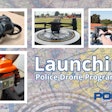A SWAT team is called out to a barricade situation. A man holed up in his house claims to have a hostage, and negotiators are getting nowhere as the subject refuses to surrender. All of a sudden the man runs out of his house wielding a baseball bat over his head. What are SWAT's options?
Thirty years ago police would have most likely shot the man, either before or after he exited the building. Now tactical teams can employ multiple less-lethal options to help end such a situation at different points throughout an incident without employing lethal force.
"The first changes came many years ago with just the munitions themselves, and over time the munitions have evolved to be more accurate and dependable," says Sandy Wall, a former Houston PD SWAT team leader and the inventor of Safariland's WallBanger bang pole.
Originally developed by the military, "non-lethal" weapons were distinguished by their intent not to kill, in contrast with all other military weapons. Now a wide variety of weapons that law enforcement calls "less-lethal" is available to SWAT with different ranges and capabilities, and therefore different applications. Every agency has its own way of utilizing these tools, but some are better suited to certain situations than others.
Dynamic Entries
When most people think of a SWAT entry, they picture a team decked out in all black head-to-toe gear carrying assault rifles and a battering ram. While serving a high-risk warrant requires having sufficient firepower on hand, less-lethal weapons serve complementary functions.
One such common tool in an entry team's arsenal is the flash-bang, or diversionary device, used to distract the subjects inside a residence. Throwing one inside a building might get the initial job done, but it can also be dangerous if not monitored.
Safariland's WallBanger is a "tactical utility pole" that holds a distraction device on one end so a team member can extend it into a window and deploy the device, then pull the pole back. This limits the effect of the sparks and heated body of the device that can ignite flammable items such as fabric or paper if it rests on them too long.
"We use the WallBanger to extend a flash-bang into a room, which provides us with about a six- to eight-second cushion to get through a door or get into the room with the subject," says Capt. James Brandon of the Corpus Christi (Texas) Police Department's SWAT team. "You still get the same effect from the diversion device, but because it's fastened to the end of the pole, the pyrotechnic threat doesn't exist."
The WallBanger, which extends to reach second-story buildings, has a breaching tip capable of breaking residential and commercial glass and can be shortened for "breaking and raking" debris around a window, says inventor Sandy Wall. It can also deploy chemical agents into a building at a safe distance.
"I went one more step and added a system where they can attach an OC canister to the pole-it's pressurized-and then they can run a hose to the breaching device and remotely deliver an OC fog formulation into the objective," says Wall. "I call it a tactical utility pole."
With its multiple uses, including explosive breaching, the WallBanger is a good example of a less-lethal device that SWAT teams must determine how and when best to deploy.
Of course there is no one right way to effect entry or to use any device. For the Gwinnett County (Ga.) Sheriff's Department, talcum powder rounds shot from a PepperBall launcher are the distraction device of choice, says Maj. Carl Sims.
After Entry
After entering a building, most tac teams carry less-lethal options with them. It's common for one or more officers to be designated for this duty. Other agencies, such as the Calvert County (Md.) Sheriff's Office, equip nearly all tactical officers on a raid with TASER devices. If entering a residence, most teams prefer having a less-lethal weapon on hand that works well within small spaces.
"We don't use launchers for a vice raid or a search warrant," says Lt. Ricky Thomas of Calvert County's Special Operations Team. "We figure the average room you stand in is going to be 10 x 10 feet. You don't need the distance with that. So you use the TASER [X26] for that application because you use it up to about 21 feet."
Another smaller weapon used in SWAT entries is the PepperBall SA-4. This relatively new four-shot device uses PAVA rounds that can be deployed individually either on the ground to disperse a chemical agent in the air or as impact rounds. Unlike a traditional PepperBall launcher, it's small enough to be carried in addition to, not instead of, a lethal weapon on SWAT operations.
"As officers are doing their movement through a building and a guy confronts an officer with something that doesn't bring it up to a lethal force confrontation, the officer can transition to the PepperBall system and shoot a couple rounds at his feet. If they don't gain compliance, they can escalate force and go to direct impact with their other two rounds," says Monte Scott, national sales and training director at PepperBall Technologies.
While it's mostly used on people, the SA-4 can also neutralize any hostile canines on a call. "So far with the SA-4, we've only deployed it five times: twice on dogs, three times on people. And it's been effective on each occasion," says Sgt. Mike Parsons of the Tulsa (Okla.) Police Department Special Operations team.
Because Tulsa PD has a part-time tactical team, patrol officers assigned to the team carry the SA-4 instead of the standard PepperBall launcher so they'll be prepared for a tactical callout at all times on duty. "The biggest advantage is they're smaller and more easily accessible for patrol officers because they wear them right on their belt," says Parsons.[PAGEBREAK]Bringing the Threat to You
Barricade situations and warrant searches often find subjects in familiar territory, giving them the upper hand. Subjects hiding in hard-to-reach areas pose an especially significant danger risk for SWAT teams. For example, an officer poking his head up into an attic is a sitting duck. To limit officers' vulnerability, it's safer to push a subject out to where the SWAT team has the advantage. Chemical agents are often the best tool for this job.
"When we have an arrest team serving a search warrant and someone runs back down to a room and we've cleared the rest of the structure, we'll try to get them to come to us with voice contact," says Parsons of Tulsa PD. "But if they don't respond we can run back outside the house and break a window and put PepperBalls into the room to push them toward the arrest team.
"Other times officers will just put PepperBalls into that room to get them to come to us [in the first place]. That way you don't have to go into that space where they are."
Armored vehicles afford even more protection for officers while deploying less-lethal devices into a structure to gain compliance. Members of the Kentucky State Police Special Response Team screw pipes onto the ends of their Protectojet projectile launchers from Advanced Materials Laboratories. This allows them to deploy the Protectojet's potent liquid chemical agent from portholes in their LENCO BearCat. Trooper Norman Preston and his team members purchase different lengths of pipe at Lowe's for different situations.
"In one incident, we fired several rounds of barricade-penetrating OC and CS into the house with no response at all. But once we located where in the house the suspect was, we were able to move the armored car close enough to deploy the Protecto-jet through an opening in the side of the house. And within probably two minutes of deployment, the suspect surrendered peacefully," says Preston.
Some enterprising officers even use similar tactics outside of buildings. "We've used PepperBalls in conjunction with 12-gauge launchers if someone on a car stop doesn't want to come out [of the vehicle], and then we'll shut the door," says Parsons. "We've ported a window with a 12-gauge launcher and then put the PepperBalls inside the car with them."
Using gas and fog in a similar way can be very effective. But the smoke devices that teams used to employ to flush people out of structures had a tendency to spark and catch buildings on fire. New chemical delivery systems don't ignite, but they don't have the ability to creep into every crevice like the old method.
This difference allows subjects to avoid the effects of the gas if they can find a space set apart from the rest of a structure, like a mudroom. Such ingenuity on the part of the bad guy requires multiple tactics to end a barricade situation.
In one such situation, Calvert County's tactical team used explosive breaching and gas with no effect. "Nothing was bringing this guy out. He just kept firing back at our armored vehicles with a shotgun," says Thomas.
"Ultimately, we did a second breach that dislodged him from where he had been hiding. That's how he had been beating the gas. Then we were able to hit him with the FN 303 [impact munition launcher] and get him in handcuffs."
Impact Munitions
Launchers like FNH USA's FN 303 that deploy impact munitions can be used in virtually any situation that requires stopping a threat from a distance through pain compliance, including barricade situations.
"We'll have one less-lethal launcher [with impact munitions] on every side of a barricaded structure. That way no matter which side the subject comes out of, we have that less-lethal ability there so that we hopefully don't have to hurt them," says Corpus Christi's Brandon.
One incident in Corpus Christi developed so quickly that when Brandon arrived on scene with the first SWAT officer and one 40mm launcher, the weapon was used immediately. A mentally ill woman wielding a knife and scissors was repeatedly running out of her house toward police and then retreating. One round above the knee was enough to stop her.
"Without tools like that there's nothing left to do," says Brandon. "If she keeps coming at you, she's going to induce a situation where someone shoots her."
Deploying from a distance is essential in ending such incidents while limiting danger to officers. "Distance gives us time and time gives us options," says Sgt. Brian Muller, head of the Technology Exploration Project at the Los Angeles Sheriff's Department.
To accommodate a variety of situations, impact munitions are available in 12-gauge, 37mm, 40mm, and in various shapes. Lightfield Less Lethal even sells a line of projectiles available in close range, mid-range, and extended range versions.
"For patrol officers, our primary less-lethal is TASER. But for SWAT, situations are often more serious and we don't want to get close enough to use it," says Brandon. "So 40mm impact munitions give us a great option."
Many SWAT teams also plan to use the TASER XREP in situations that call for a less-lethal projectile. These wireless fin-stabilized devices deploy from 12-gauge shotguns pack a punch and have the added benefit of incapacitating a subject, just like an X26. If you're dealing with a noncompliant person who isn't feeling pain, this can still stop him from a distance.
Impact munitions can even be used on inanimate objects. Calvert County's tactical unit uses its FN 303 launchers to safely shoot out lights to darken an area around a barricaded building.[PAGEBREAK]Making the Right Decision
The immense variety of less-lethal options available to SWAT can be overwhelming and confusing, which is why it's so important to coordinate their use.
"If we have a barricaded subject, we have someone designated as the less-lethal person and he'll have the responsibility for configuring all the different applications," says Thomas. "From bean bag to TASER to the XREP to the FN 303. Or if we want something bigger, the 37mm launchers that shoot out projectiles."
Having someone on site to coordinate use of less-lethal options for each call is important, but it doesn't stop there. With additional flexibility comes the need to make judgment calls depending on the situation.
"Less-lethal weapons, in my opinion, are much more complicated than guns. They all work, but you have to understand the conditions in which you can use them," says LASD's Muller.
Wall agrees: "That's where proper training comes in, along with realistic expectations and performance under stress." He believes every officer should not just be trained but also certified to use each less-lethal option in his or her arsenal.
Training with local teams is also essential. On a joint call, everyone needs to be on the same page, especially because some less-lethal devices can sound like gunfire when deployed, which can cause confusion and tragic consequences. Beyond this, teams training in less-lethal devices need to incorporate the use of lethal force to employ sound tactics. "They've got to continually remind themselves in training and in application to have lethal coverage there," says Thomas. "Unless you have lethal coverage over you, you need to employ your lethal option first."
After spending 28 years in law enforcement, most of them with Houston PD's SWAT team, Wall also worries that today's tactical officers depend too much on less-lethal.
"I always caution teams to not take too many chances, especially when faced with an armed subject who has every intention of harming himself and or others," says Wall. "Sometimes officers take too many chances to employ less-lethal munitions or tactics and actually put themselves in undue danger.
"We always say, 'Never bring a beanbag to a gunfight.' If the suspect has a firearm, in most situations I would think less-lethal weapons are not appropriate."
Determining the right less-lethal application for a situation requires having a plan for every eventuality, but being willing to adjust quickly based on the circumstances, which can change rapidly. And that might mean using deadly force. Unfortunately, the public often doesn't see it that way. But the truth is sometimes people die. Officers might need to use lethal force, or a less-lethal weapon might lead to a death.
"Wouldn't the public love it if we had phasers and could just make the bad guys be stunned like in Star Trek and not have to shoot them?" quips Thomas. "We're there to save lives. But we have to guard against [the idea that there's] a 100-percent fix-all, save-all less-lethal option that's going to take care of every situation. It's just not there."
LESS-LETHAL WEAPONS:


















